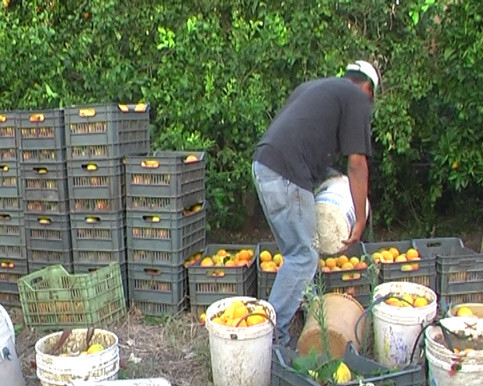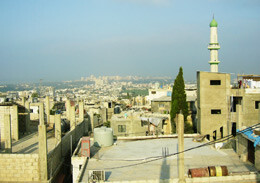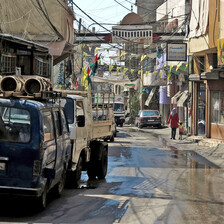Burj al-Shemali refugee camp 19 October 2008

A Palestinian worker from the Burj al-Shemali refugee camp unloads oranges. (a-films)
The sun has yet to rise at an orange plantation in the hinterland of the southern Lebanese city of Tyre. Muhammad has just transferred ten buckets of oranges into black plastic boxes at the edge of the orange grove. After carrying the empty buckets back to the other workers, he says: “After this work I return home, rest for an hour and leave for my second job as a decorator. Harvesting oranges alone doesn’t feed my family.”
This morning around half past five, the foreman, whom I will call “Abu G” and his dozen workers drove to the plantation in a blue minivan. One hour later, the men are busily fulfilling their specific tasks. Two balance on ladders and pluck oranges from the top of the trees while Muhammad and some others pick from the lower branches. From time to time, between six and ten buckets are being carried away at once. After sorting the oranges, they are put into boxes which are then loaded on a small truck that takes them to the north of Lebanon, and from there they are exported to other countries in the region. While his workers sweat away, the foreman lays down on a piece of cardboard. Even if the foreman-laborer power disparity is sharp, they all have one thing in common: they are Palestinian refugees living at the Burj al-Shemali refugee camp.

A view from above the Burj al-Shemali refugee camp. (a-films)
Early in the morning, between 5 and 6am, a wave of footsteps and whispering voices can be heard in the camp’s narrow alleys. Silence follows and lasts until half past seven, when hundreds of sleepy pupils walk to school. It is in the darkness of the early morning hours that hundreds of day laborers leave their homes, gather in the streets and then head to their work in the fields and plantations of the region. Among them are youth, university graduates and grandparents. Some work in the fields, but most of them harvest oranges, lemons and bananas. Before noon, most of the workers return to the camp. However, it isn’t the end of their work day.
Lebanese law treats the more than 400,000 Palestinian refugees in the country as foreigners. Therefore they are not allowed to own land, they are forbidden to work in over 70 white and blue-collar jobs, they aren’t guaranteed a minimum wage and they aren’t integrated into the Lebanese social and medical insurance system. These various forms of exclusion make them vulnerable in many ways. Many refugees depend on the services and assistance by the UN agency for Palestine refugees, UNRWA, and on remittances from their relatives abroad. Highly qualified Palestinians like doctors or engineers, who are not allowed to practice their professions in Lebanon, find themselves behind the steering wheels of taxis, in the countless small shops in the refugee camps or as day laborers in construction or agriculture.
Hajja Amne, 65 years old, says that she worked hard in agriculture throughout her whole life, but never received any benefits. Now her health problems prevent her from working. Although pleased by the wage hike that was the result of a strike by Palestinian harvest workers in the beginning of the year, she is disturbed by the fact that men still earn more than women for the same work. She also complains, “If a worker is sick and can’t work, she won’t get paid.” However, the workers aren’t only being exploited by the Lebanese landowners and employers, but sometimes also by their own foremen. They often line their pockets with an unjustified amount of the money siphoned from the wages of the laborers. While some foremen themselves participate in the harvest, others limit their activity to commanding the workers and, as in the case of Abu G., resting in the grass.
Efforts have been made towards a collective organization of the Palestinian day laborers in agriculture. The struggle for higher wages in the beginning of this year is one of several indicators. According to Hosni, a foreman who identifies as communist, ideas regarding the establishment of an autonomous insurance system by the workers were discussed. However, nothing has been implemented so far, and barriers to self-organization can be found in the fragmented political landscape in the camps. Even in the extreme case of Nahr al-Bared, the refugee camp in northern Lebanon destroyed by the Lebanese army last year in fighting a Sunni militant group that had occupied part of the camp, the Palestinian parties can hardly manage to put aside their differences to work together toward the collective interest of the refugees.
Meanwhile, Muhammad continues to leave the camp seven days a week in the early morning in order to work in the orange groves. A few years ago, he built another floor on top of his parents’ house in the camp and got married. Since then, his wife gave birth to a baby girl. “As a Palestinian you don’t learn an occupation and stay in the same business until the end of your life,” says Muhammad. “We have different work experiences in various fields and often we work in several places at the same time in order to make money.”
Ray Smith is an activist with the anarchist video collective, a-films (http://a-films.blogspot.com). In a workshop in Burj al-Shemali camp conducted in September 2008, the collective produced a short movie on Palestinian day laborers in agriculture: http://a-films.blogspot.com/2008/10/video-harvesting-oranges.html.



